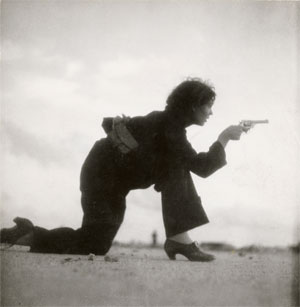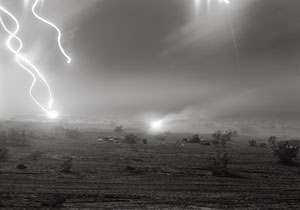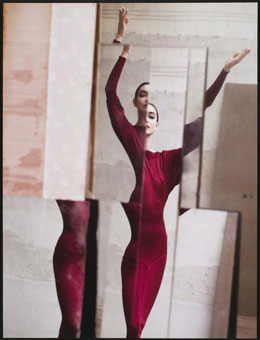A Center of Concern
John Haberin New York City
ICP at 50 and David Seidner
Photography at the Morgan Library
The International Center of Photography would like you to know: it is concerned.
It is concerned not just about you, politics and wars, or even the planet, although its center of concern has been growing ever since its founding. A celebration of its fiftieth anniversary encompasses more than one hundred fifty works, spanning at least as many years and much of the globe. It has kept rethinking photography along the way. What began as the hopes of a leading photojournalist to keep his vision alive has changed, along with its name.  "ICP at 50" opens with portraits of Americans, but African Americans—as couples, at choir practice, and alone. You can only guess at what follows.
"ICP at 50" opens with portraits of Americans, but African Americans—as couples, at choir practice, and alone. You can only guess at what follows.
"I'm HIV positive. It doesn't have to be negative." So runs a magazine ad that David Seidner accompanied with his own photograph, of himself. Can his optimism withstand his dying and his anxiety over what he had become as an image maker? It cannot be an accident that ICP's concern for dignity leads into a second, smaller show of Seidner, who died of AIDS. By contrast, new acquisitions in photography at the Morgan Library seem blissfully secure.
That look at Seidner opens with a self-portrait. Retrospectives often do, but he was a fashion photographer first and foremost. It consumed pretty much the entirety of a sadly abbreviated life. Yet surely fashion photography is not about the photographer, right—and not about art? Such, at least, is convention, but his torn allegiance powered some provocative art. You may return to "ICP at 50" chastened and questioning.
A soft spot for journalism
The center's very origins lay in concern, and the C in ICP first stood for just that. Cornell Capa created the International Fund for Concerned Photography in 1956, in concert with Robert Capa, David "Chim" Seymore, Werner Bischof, and Dan Weiner, becoming the ICP we know in 1974. To this day, it boasts of the lines out the door for its opening. I still miss how well its Fifth Avenue mansion showed off photography, although I have followed it on its journey to a midtown office lobby, a basement space on the Bowery, and (with luck) a permanent home on the Lower East Side across from the Essex Market. It may not have space off the entrance for more than coffee and a gift shop, but it has a library, media labs, and a school. One of two floors for galleries has narrow walkways, but it pays off in the drama of looking down, not to a bloated museum atrium, but to art.
It can also boast of the two hundred thousand prints in its collection, so many that "ICP at 50" can handle only one per photographer. (You will just have to take its word that Elisabeth Sherman, Sara Ickow, and Haley Kane as curators, examined each and every one.) The show is a survey of photography all by itself. The section on the nineteenth century also points to a changing medium—from tintypes that allowed only one-off prints to plates that could print again and again. An unknown photographer, it turns out, printed in color as early as 1935, decades before the saturated colors of Helen Levitt and William Eggleston. But then Levitt's legs sticking out from under a car are street photography, too.
ICP will always have a soft spot for photojournalism. It has had recent shows of Magnum Photos, with its dedication to social history, and Robert Capa in Spain. The older of the Capa brothers, he witnessed the Spanish Civil War from the point of view of those who fought against fascism and lost. Sure enough, the poster photo for "ICP at 50," by Gerda Taro, depicts a Spanish militia member in dramatic profile, raising her pistol. The show then leaps ahead to Martin Luther King, Jr., from Weiner, and JFK shaking hands from Cornell Capa himself. One need not claim a photo of the lunar lander for fine art, not when it is credited to NASA rather than an artist, but why try when the medium reaches to the moon?
Still, the story continues. Diversity remains in focus well after early black America. Gordon Parks has Ralph Ellison in a midnight hideaway like the protagonist of Invisible Man, but with music, making blackness audible and visible. Paul Mpagi Sepuya puts his own black body in question in a mirror study, and Mickalene Thomas looks as ever at herself. For once, her glitzy self sits off center and closer to the rear of her tacky surroundings. Taro's Spaniard is kneeling, as much to display her youth and beauty as to take better aim.
Just ticking off the women contributors would be a lost cause. Lorna Simpson, Carrie Mae Weems, and Deana Lawson continue their unraveling of black identity, in the case of Simpson with enigmatic text. Others were creating modern photography, including Margaret Bourke-White, Dorothea Lange, Berenice Abbott, and Ilse Bing, whose shades of gray look more vivid and mournful every day. Still others mark the shift to present-day concerns. It is not just a matter of feminism or a matter of pride. When an unseen woman for Lee Friedlander casts her shadow on another woman, her back to the camera, she is casting a long shadow on photography itself.
It is about what photography does and is. For An-My Lê, photography's public record can only approach her private history as a woman from Vietnam. But then ICP has always had its private side, like the intimate records of "Love Songs," "Face to Face," and "Close Enough" in just the last year. It has also begun to challenge photography as a reliable medium. That is where Postmodernism and such women as Laurie Simmons, Louise Lawler, and Barbara Bloom come in. Simmons and Lawler have their dolls and rephotography, while Bloom needs a whole wall to place images in an uncertain museum context.
One last step
Public and private were hard to separate all along, like photography and art. Henri Cartier-Bresson, too, helped to found Magnum, but he also defined art photography for generations as the "decisive moment." Can ICP take one last step, from representation to abstraction? Not exactly, but change comes from an unlikely source. Robert Rauschenberg, rarely a photographer and hardly a formalist, turns a stairwell into a study in black and white. The steps themselves approach Modernism's grid.
You might think again of those steps when you come to the stone tiers of a college amphitheater, from Imogen Cunningham, and again on opening day at Ebbets Field, in a photo by Charles E. Stacy. From breaking events to abstraction and back, photography has come full circle.  ICP is not so much broadening its mission as reinterpreting it each and every day. Sure, this is street photography, but the streets of New York now belong to the loser at a diaper derby by Diane Arbus. And sure, Weegee joins in her freak show, but on the set of Dr. Strangelove.
ICP is not so much broadening its mission as reinterpreting it each and every day. Sure, this is street photography, but the streets of New York now belong to the loser at a diaper derby by Diane Arbus. And sure, Weegee joins in her freak show, but on the set of Dr. Strangelove.
The show does only what you expect, only not necessarily when you expect it. Photography can still keep up with the news, like Bill Biggart on 9/11, but his car coming at you out of a cloud of dust seems to belong less to tragedy than to a vision. It can still make news as well, as childishly and notoriously as Piss Christ by Andres Serrano. It can still write home, but the letter may go from Samuel Fosso to his ancestors in Africa. Dining on the Congressional Limited, by Robert Frank, hangs next to diners in Brussels with their dog, by Eliot Erwitt. Who can say which deserves the headlines?
An exhibition is not a text book. Can a selection, anywhere, lay claim to a comprehensive history of photography—and what can it claim if not? This is not the institution to play around, and what is art without room for play? The nice thing about an anniversary is that you do not have to ask. Shirin Neshat may sum it all up in a single image, of Persian writing across a downturned face. Public and private ends of photography can be equally moving and equally inscrutable.
ICP may shy away from abstraction, but the Morgan Library cannot get enough of it. It appears often among recent acquisitions in photography. All came to the Morgan since it established a photography department in 2012. Just as interesting as the images (or refusal of images) is the variety of means used to create them. Than can mean brushed chemicals for Chargesheimer (a German photography), a distorting lens for Weegee, cut-and-past fragments of photography for Joe Rudko, books stacked like white paper bricks for Mary Ellen Bartley, or a mere close-up for Carl Van Vechten. Irving Penn can turn most anything, from a whirl of fashion to food, into form alone.
The Morgan finds art itself glamorous, because it, too, is a class act. It has a whole wall for photos of celebrities in the arts, and they play their parts well. Add in a group shot of a supportive dealer and her roster of artists, by Peter Hujar, and you can almost forget Hujar's vulnerability and honesty in the face of AIDS. Eleanor Antin mailed out dozens of her photos as postcards, and the Morgan managed to get a complete set back. She had crossed the country, ending at the Museum of Modern Art, and this was her message to the country in return. It may lose something on going from conceptual art to a monument, but one can always end instead at ICP and start your own journey anew.
The fashionista himself
Photography is always about looking, through the camera and the human eye behind it. It is also about making you want to look—for photojournalism, at the urgency of breaking events. For fashion photography, that means making you look at a look that you will want for yourself. It is a work for hire about work for sale, and David Seidner knew that, too. He snagged a contract, an exclusive contract, with Yves Saint Laurent. He loved it because photography for him was always about appearances, ones that he could manipulate and turn on himself.
Seidner in that self-portrait is lying down, looking seductive, provocative, and vulnerable. He turns the camera on other men as well, with an overlaid black grid. It defines his work as art back when the grid of late Modernism ruled. It also highlights the body and dismembers it. That can mean a naked body, a clothed body, or, in other work, a fragment of clothing alone.  It is a polished image but also a teaser for what may never come.
It is a polished image but also a teaser for what may never come.
He brings the same versatility to fashion. He directs the eye to the model and the designer, and he does not distinguish the two. A magazine feature about a designer requires no less. He elevates his subject while taking it apart and reassembling it, with multiple exposures and with mirrors. Nicely dressed mannequins look more individual and alive than many a professional model. One can almost claim to know what they are thinking.
If that were not sufficiently a matter of art, Seidner devotes a series from the 1990s to well-known artists. Hung in four rows of four photos apiece, their unsmiling faces appear up close, approaching you and challenging you. Naturally he includes himself, as a boast but also in wonder as to whether he belongs. And then he is back with clothing, billowing outward. One hardly knows whether he has fallen prey more than ever to fashion or turned away from the model. The conventions and the fashion still turn me off, but they have me thinking.
An eye to appearances is also an eye on gender, and Seidner was gay. He died of AIDS in 1999, at forty-two. One might see his work as his coming out or anxiety about his identity. It has its parallel in art and anti-art photography of his time, like that the self-portrait as a pose for Cindy Sherman or dolls in place of mannequins for Simmons. It looks ahead to painting by women today that makes a point of the body but minimizes the self-questioning. I hardly know whether to call Seidner more or less radical.
He accords with the current interest not in minimizing fine art, but in refusing to set it apart from design and craft—no more than photography from painting. Museum shows of fashion are still mostly pandering, but the Jewish Museum has recovered magazine photography for art as well. ICP sees Seidner as long neglected but vital to its collection. It has his tear sheets, but it ends with something else again. A final series sets orchids in blurred close-up against a backdrop of fabric. It becomes pure color, but still an emblem of impending death.

"ICP at 50" and David Seidner ran at the International Center of Photography through March 6, 2024, new acquisitions in photography at The Morgan Library through May 26.




